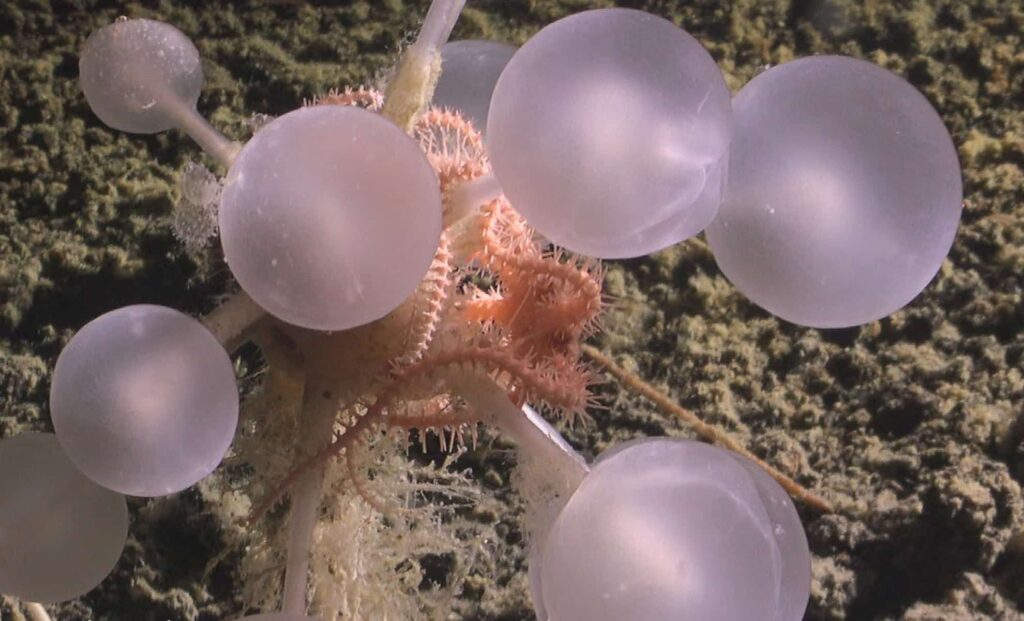Found at an astonishing depth of nearly 12,000 feet in the South Sandwich Trench near Antarctica, the creature is part of a growing list of bizarre marine life uncovered during deep-sea explorations. Its appendages, ending in gelatinous orbs covered in micro-hooks, trap small crustaceans with deadly precision.
This discovery comes from a series of oceanic expeditions that have been mapping the seafloor and uncovering strange and previously unknown species lurking in the dark, remote reaches of the ocean. While sponges have traditionally been known as passive filter feeders, some species—like this new “death-ball” variety—have evolved into carnivores, ensnaring their prey with specialized structures. Researchers believe that the depths of the ocean, largely unexplored, still hold many more surprises.
The Cladorhizidae Genus and Its Carnivorous Sponges
The “death-ball sponge” belongs to the Cladorhizidae genus, which includes only carnivorous sponges. This genus is known for its unusual feeding strategy—catching and consuming prey instead of filtering plankton from the water.
Such sponges possess intricate appendages, often with hooks or spicules, designed to snare small creatures like amphipods and isopods. This discovery adds to the growing knowledge of these strange sponges, which were only recognized as carnivorous in the 1990s.
Researchers first discovered carnivorous sponges in the mid-1990s, during a dive in France, where they identified Abestopluma hypogea, a sponge that captures crustaceans with long, tendril-like structures. The “death-ball sponge,” with its orbs of micro-hooks, is an even more specialized version of this hunting strategy. However, its exact species name is still under investigation, as it continues to intrigue scientists with its peculiar morphology and behavior, reports Popular Mechanics.

A Deep-Sea Treasure Trove
The “death-ball sponge” was found during an expedition led by the Schmidt Ocean Institute aboard the R/V Falkor and the SuBastian ROV. This particular dive took place at a depth of 11,814 feet in the South Sandwich Trench off the coast of Antarctica.
The region, largely unexplored due to its extreme depth and isolation, has proven to be a hotspot for newly discovered species. The same team had previously captured footage of a juvenile colossal squid, another unprecedented finding in deep-sea exploration.


The expedition, which began in April 2023, has already yielded thousands of images and hours of video footage, revealing an array of new species, including iridescent armored scale worms and bizarre black corals.
With advanced imaging and seafloor mapping technologies, researchers are uncovering ecosystems thriving in these harsh, lightless environments. According to Jyotika Virmani, Executive Director of the Schmidt Ocean Institute, this technology makes it possible to explore and gather data from areas that were previously beyond reach.


The Mysteries of the Deep Ocean
Despite the remarkable discoveries so far, the Southern Ocean remains profoundly under-sampled, with less than 30% of the samples from this expedition assessed. This leaves a vast portion of the deep-sea environment unexplored, with many more species likely waiting to be uncovered.
The Cladorhizidae family, with its diverse and terrifying members, exemplifies the bizarre creatures that continue to defy our understanding of marine life. Researchers believe there could still be far more to discover about these elusive organisms and the complex ecosystems they inhabit.
In the coming years, marine biology may undergo a profound shift as more of the deep ocean’s secrets are revealed. The “death-ball sponge” and its kin offer just a glimpse into a hidden world that remains one of Earth’s last frontiers.

